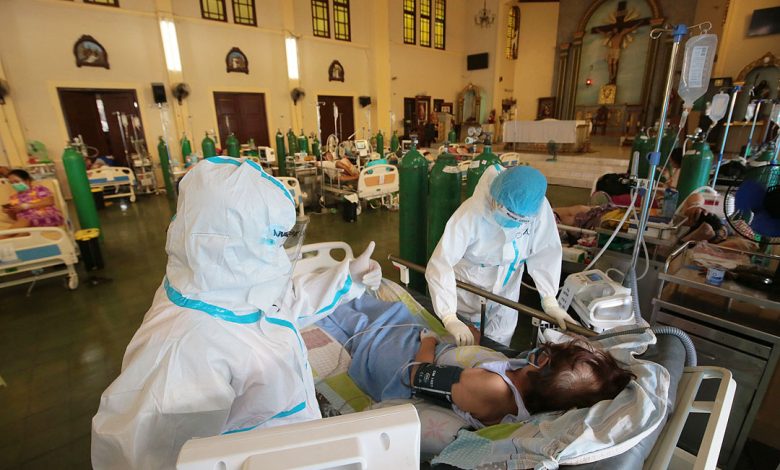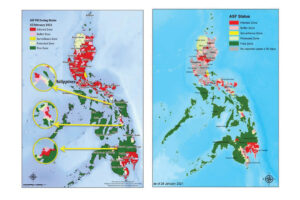COVID numbers may top past surges, says OCTA

HEALTH workers attended to coronavirus patients at the chapel of the Quezon City General Hospital on Aug. 2. — PHILIPPINE STAR/ MICHAEL VARCAS
CORONAVIRUS infections in the Philippines would probably continue rising and top past surges due to the highly mutated Omicron variant, according to researchers from the country’s premier university.
Metro Manila’s daily positivity rate has hit 28%, near the all-time high of 30%, Fredegusto David, OCTA Research Group fellow from the University of the Philippines said on Sunday.
Daily coronavirus cases could hit more than 10,000 in Metro Manila in the worst scenario, he told the ABS-CBN News. “It’s just possible, I’m not predicting it yet. But it seems like we’re heading there.”
Antonio C. Leachon, a doctor and former special adviser to the country’s pandemic task force, told ABS-CBN TeleRadyo daily cases might reach 20,000.
The Department of Health (DoH) has reported 14 Omicron cases in the Philippines.
The variant dampened New Year festivities around the world, with Paris canceling its fireworks show, London relegating its own to television and New York City scaling down its famous ball drop celebration at Times Square.
Globally, airlines canceled more than 6,000 flights on Christmas Eve, Christmas and the day after Christmas as COVID-19 cases surged. In the United States, more than 1,200 flights were canceled and more than 5,000 were delayed on Dec. 26 alone as staff and crew called out sick.
DoH reported 4,600 coronavirus infections on Sunday, bringing the total to 2.85 million.
The death toll hit 51,570 after 25 more patients died, while recoveries increased by 535 to 2.78 million, it said in a bulletin.
The agency said 19.6% of 26,122 samples on Dec. 31 tested positive for COVID-19, more than the 5% benchmark set by the World Health Organization.
There were 21,418 active cases, 769 of which did not show symptoms, 15,644 were mild, 3,081 were moderate, 1,589 were severe and 335 were critical.
The agency said 99% of the reported cases occurred from Dec. 20 to Jan. 2. The top regions with infections in the past two weeks were Metro Manila with 3,279 cases, Calabarzon with 676 and Central Luzon with 252.
It said 28% of the reported deaths occurred in December, 8% in November, 4% in October and 16% in September.
The Health department said 22% of intensive care units in the Philippines were occupied, while the rate for Metro Manila was 27%.
Mr. David said coronavirus infections have been spiking, mostly concentrated in Metro Manila.
The region’s high vaccination rate could ease the effects of the virus on people’s health, he added. The infection surge also might not last as long.
He said the government should consider placing Metro Manila and nearby provinces in a bubble to avert its spread to other regions. Provinces should also consider enforcing stricter border control.
President Rodrigo R. Duterte has raised the coronavirus alert in Metro Manila to Level 3 from Jan. 3 to 15 amid rising infections.
State-run Philippine General Hospital has posted a steady increase in COVID-19 patients, spokesman Jonas del Rosario said.
“There were 93 confirmed COVID-19 cases in the hospital as of Jan. 1 from a low of 30 on Dec. 25,” he said in a text message.
Gene A. Nisperos, a board member of the Community Medicine Development Foundation, Inc., said the fresh surge could not be blamed solely on people having moved more freely during the holiday.
“Even the DoH has already stated that there is community transmission of Omicron,” he said in a Facebook Messenger chat.
The Delta variant, which has become the dominant strain in the Philippines, nearly exhausted the country’s health system last year.
Meanwhile, Albay Rep. Jose Ma. Clemente S. Salceda said the country’s best defense against the Omicron variant is to isolate the infected and to heal them quickly.
While the Omicron variant appears to be more infections, it is also less deadly, he said in a statement.
The congressman said the government should reactivate unused isolation facilities to prepare for the surge.
“It is essential for economic recovery that we do not lose the momentum in demand and job creation that we have already sustained,” he said. “So we have to get fighting this variant right.”
Mr. Salceda, who heads the ways and means committee, said Congress could adjust the budget so the government could buy more medicines, ventilators and other medical supplies to prepare for a sudden increase in hospitalizations. — Norman P. Aquino, Kyle Aristophere T. Atienza and Jaspearl Emerald G. Tan




